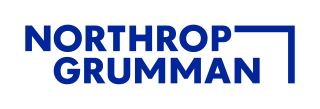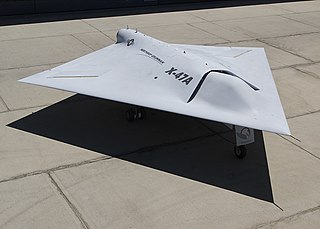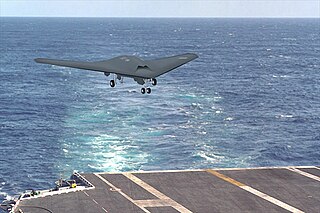
The Defense Advanced Research Projects Agency (DARPA) is a research and development agency of the United States Department of Defense responsible for the development of emerging technologies for use by the military.

The Northrop Grumman RQ-4 Global Hawk is a high-altitude, remotely-piloted surveillance aircraft introduced in 2001. It was initially designed by Ryan Aeronautical, and known as Tier II+ during development. The RQ-4 provides a broad overview and systematic surveillance using high-resolution synthetic aperture radar (SAR) and electro-optical/infrared (EO/IR) sensors with long loiter times over target areas. It can survey as much as 40,000 square miles (100,000 km2) of terrain per day, an area the size of South Korea or Iceland.

Northrop Grumman Corporation is an American multinational aerospace and defense technology company. With 95,000 employees and an annual revenue in excess of $30 billion, it is one of the world's largest weapons manufacturers and military technology providers. The firm ranks No. 101 on the 2022 Fortune 500 list of America's largest corporations.

The Boeing X-45 unmanned combat air vehicle is a concept demonstrator for a next generation of completely autonomous military aircraft, developed by Boeing's Phantom Works. Manufactured by Boeing Integrated Defense Systems, the X-45 was a part of DARPA's J-UCAS project.

The Northrop Grumman X-47 is a demonstration unmanned combat aerial vehicle. The X-47 began as part of DARPA's J-UCAS program, and is now part of the United States Navy's UCAS-D program to create a carrier-based unmanned aircraft. Unlike the Boeing X-45, initial Pegasus development was company-funded. The original vehicle carries the designation X-47A Pegasus, while the follow-on naval version is designated X-47B.

The Northrop Grumman MQ-4C Triton is an American high-altitude long endurance unmanned aerial vehicle (UAV) developed for and flown by the United States Navy as a surveillance aircraft. Together with its associated ground control station, it is an unmanned aircraft system (UAS). Developed under the Broad Area Maritime Surveillance (BAMS) program, the Triton is intended to provide real-time intelligence, surveillance and reconnaissance missions (ISR) over vast ocean and coastal regions, continuous maritime surveillance, conduct search and rescue missions, and to complement the Boeing P-8 Poseidon maritime patrol aircraft.

Joint Unmanned Combat Air Systems, or J-UCAS, was the name for the joint U.S. Navy and U.S. Air Force unmanned combat air vehicle procurement project. The two vehicles involved in the project were the Boeing X-45 and Northrop Grumman X-47. J-UCAS was managed by the Defense Advanced Research Projects Agency. In the 2006 Quadrennial Defense Review, it was stated that the J-UCAS program would be terminated and instead a new long-range strategic bomber program, "Next-Generation Bomber", for the Air Force has been launched. The program was revitalized into a Navy-only program named UCAS-D.

The BQM-74 Chukar is a series of aerial target drones produced by Northrop. The Chukar has gone through three major revisions, including the initial MQM-74A Chukar I, the MQM-74C Chukar II, and the BQM-74C Chukar III. They are recoverable, remote controlled, subsonic aerial target, capable of speeds up to Mach 0.86 and altitudes from 30 to 40,000 ft.

The Boeing X-46 was a proposed unmanned combat air vehicle (UCAV) that was to be developed in conjunction with the United States Navy and DARPA as a naval carrier-based variant of the Boeing X-45 UCAV being developed for the U.S. Air Force. Two contracts for technology demonstrators were awarded in June 2000, to Boeing for the X-46A and to Northrop Grumman for the X-47A.

The Northrop Grumman X-47B is a demonstration unmanned combat aerial vehicle (UCAV) designed for aircraft carrier-based operations. Developed by the American defense technology company Northrop Grumman, the X-47 project began as part of DARPA's J-UCAS program, and subsequently became part of the United States Navy's Unmanned Combat Air System Demonstration (UCAS-D) program. The X-47B is a tailless jet-powered blended-wing-body aircraft capable of semi-autonomous operation and aerial refueling.

The Northrop Grumman Switchblade was a proposed variable sweep oblique wing unmanned aerial vehicle studied by Northrop Grumman for the United States.
The Unmanned Combat Armed Rotorcraft or UCAR was a program carried out by DARPA and the United States Army in 2002-2004 to develop an unmanned combat helicopter.

The Heterogeneous Aerial Reconnaissance Team (HART)—formerly known as the "Heterogeneous Urban RSTA Team (HURT)"—program was an aerial surveillance project funded by the Information Processing Technology Office of the Defense Advanced Research Projects Agency with program managers John Bay and Michael Pagels. The purpose of the program was to develop systems that could provide continuous, real-time, three-dimensional surveillance of large urbanized areas, using unmanned aerial vehicles. The project team was led by Northrop Grumman Corporation, and involved several other academic and corporate researchers.

The Boeing Phantom Ray is an American demonstration stealth unmanned combat air vehicle (UCAV) developed by Boeing using company funds. The autonomous Phantom Ray is a flying wing around the size of a conventional fighter jet, and first flew in April 2011. It will conduct a program of test flights involving surveillance, ground attack and autonomous aerial refueling missions. The developers say it can carry 4,500 pounds of payload.

KQ-X was a $33 million DARPA program awarded to Northrop Grumman on July 1, 2010. KQ-X investigated and developed autonomous aerial refueling techniques using two NASA Global Hawk high-altitude long endurance (HALE) unmanned aerial vehicles (UAVs).
The DARPA XS-1 was an experimental spaceplane/booster with the planned capability to deliver small satellites into orbit for the U.S. Military. It was reported to be designed to be reusable as frequently as once a day, with a stated goal of doing so for 10 days straight. The XS-1 was intended to directly replace the first stage of a multistage rocket by taking off vertically and flying to hypersonic speed and high suborbital altitude, enabling one or more expendable upper stages to separate and deploy a payload into low Earth orbit. The XS-1 would then return to Earth, where it could ostensibly be serviced fast enough to repeat the process at least once every 24 hours.
The Northrop Grumman RQ-180 is an American stealth unmanned aerial vehicle (UAV) surveillance aircraft intended for contested airspace. As of 2019, there had been no images or statements released, but growing evidence points to the existence of the RQ-180 and its use in regular front-line service. The use of the nickname "White Bat" in a 2021 video released by the US Air Force Profession of Arms Center of Excellence (PACE) suggests that the military may be preparing to release information on the RQ-180.

The Kratos XQ-58 Valkyrie is an experimental stealthy unmanned combat aerial vehicle (UCAV) designed and built by Kratos Defense & Security Solutions for the United States Air Force's Low Cost Attritable Strike Demonstrator (LCASD) program, under the USAF Research Laboratory’s Low Cost Attritable Aircraft Technology (LCAAT) project portfolio. It was initially designated the XQ-222. The Valkyrie completed its first flight on 5 March 2019 at Yuma Proving Ground, Arizona.















